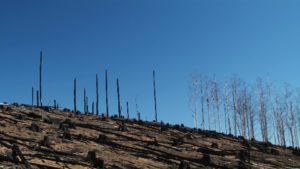An expert review on logging after bushfires found it removes tree hollows which are vital in the recovery of more than 225 native species.
The review of scientific studies on post-fire logging by The Bushfire Recovery Project, a joint initiative of Griffith University and the Australian National University, reported 114 species of birds, 18 mammals, 79 reptiles and 27 amphibians which use tree hollows as homes, are threatened by post-fire logging.

Professor Brendan Mackey, Director of the Griffith Climate Action Beacon and Griffith Climate Change Response Program
The key findings of the report on post-fire logging in Australia were:
- After severe fire, tree hollows in old trees continue to provide homes for many birds, animals and reptiles, even if the tree dies. They also provide shelter for animals in subsequent fires.
- Post-fire logging removes tree hollows which are vital in the recovery of populations of 114 birds, 18 mammals, 79 reptiles and 27 amphibians use tree hollows as homes, including sugar gliders, kookaburras, goannas and parrots.
- Scientific studies on areas which were logged after fire show far fewer species of birds than in areas left alone, understory trees such as tree ferns struggle to recover, erosion increases, and soil quality reduces making it harder for the forest to bounce back.
- Logging after fire reduces the water yield from the forest for decades because the wall of young growing trees drink much more water than mature forest, which means less water left to drain into catchments such as the Thomson and Yarra (Melbourne’s water supply).
- Post-fire logging does not reduce fire risk and may increase it in the short term by drying the forest out, increasing the fuel load and increasing wind speed.
Post-fire logging began in the Northern Hemisphere where fires tend to kill all the trees in the forest but in Australia, most trees survive intense bushfires as they’ve evolved with fire for 60 million years.

A forest landscaped logged post-fire
Griffith University ecologist Dr Patrick Norman said animal habitat such as tree hollows tended to remain intact after fire, but post-fire logging removes that habitat.

Dr Patrick Norman, an ecologist with the Griffith Climate Change Response Program
“Hollow trees are a key requirement for recovery and rebound in many species of Australian wildlife, because that’s where they live,’’ he said.
Griffith University Professor and Intergovernmental Panel on Climate Change coordinating Lead Author Brendan Mackey said the review revealed concerns that, given the combined impacts of both fire and logging, almost all hollow-bearing trees in some forests may be gone before new ones develop.
“Tree hollows take at least 120 years to form, but usually more like 170-220 years,” said Dr Norman.
“The scientific papers we reviewed found far less species of birds are found at sites which were logged after fire, with some species of birds found only in forest older than 200 years.”
ANU’s Professor David Lindenmayer AO said post-fire logging occurs when the forest is most vulnerable and creates increased run-off, erosion, water quality problems and less water yield due to the thirsty, growing young trees which replace the mature forest.
“The evidence shows post fire logging also has very long-term effects on soil nutrient and structure, drying out the soil.”

